February 7 2007
Last Updated 5/23/07
 |
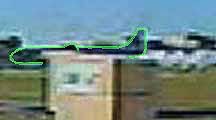 |
I'm sure it was addressed somewhere in the thread, but a 757 shouldn’t have a vapor or smoke trail behind it if it crosssed the Pentalawn. The normal contrail seen behind jets in the sky is a result of high altitudes, and does not happen near ground level. I didn’t know this until I learned of it from Karl Schwarz of all people, but it seems to be true anyway. Thus the vapor trail meant a missile, which burns rocket fuel that does leave a trail at sea level (although that doesn’t seem to explain an A3 Skywarrior any better than it does a 757).
Mike Wilson’s animation of the attack helps explain and visualize the source of smoke as consistent with a 757 with engine damage, proably from ingesting a light pole "luminary." But like Cat Herder, I believe he got the plane and this smoke confused in the still analysis. Again as have most others, he identified the plane as hidden behind the security box - what they show as tailfin is the same tall part of the horizon line, and what I believe is the plane is shown as the engine smoke.
Allow me to explain: there are things we can tell from these stills if we look close. The first thing is to look not just at the first still but at all five to get asense of motion. the five frames below are closely cropped on the area in question, slightly enhanced, with the fisheye effect uncorrected. I've looked for movement and stillness, measured by changes in pixels from one frame to the next. Spots that match up in frame after frame I've taken as stationary objects/background and the few that don’t I've taken as things that are moving. The plane/missile was moving, so clearly we look for pixels that change suddenly. for the moment I'm ignoring the black tailfin to simplify this stage of the analysis, but I'll get back to it shortly.
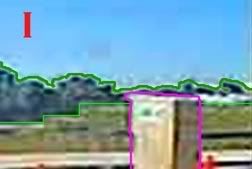 |
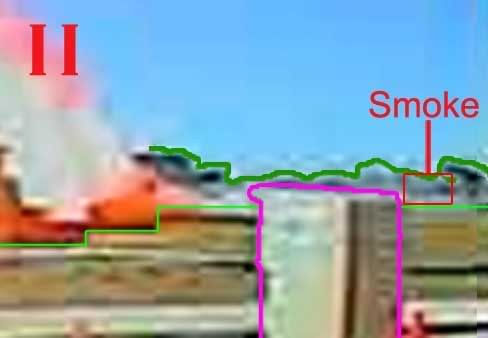 |
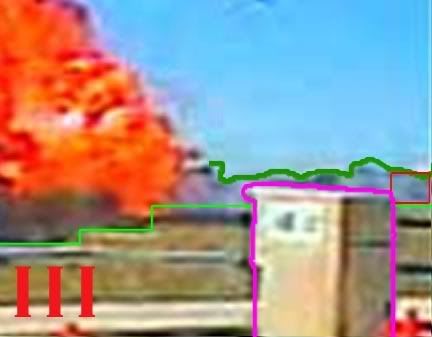 |
Frame three:
Again this is about one second after the previous. Note the gray smoke hasn't changed much, even as the fireball evolves, rises slowly, and darkens.
 |
Frame Four:
No significant change in color of smoke, projectiles working their way up through the cloud and emerging.
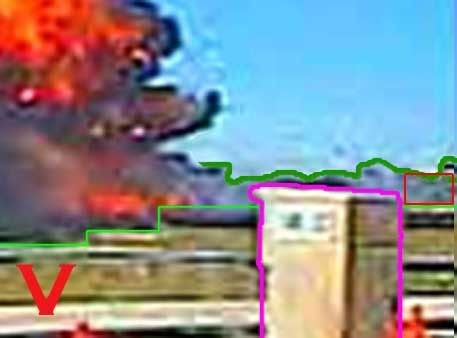 |
Frame Five: Same. gray smoke,expanding and darkenin explosion. the little white "nosecone" some have seen peeking out from behind the security box is still there, attached to the box.
 So then lets revisit the first frame here in simplified cartoony colors – background, forground, building and shadow, check-point, and the “blur.” Looking also at the color of “smoke” in the red sample area from the five stills, we see a sudden shift from white to gray, which stays gray for the next four seconds. Clearly the white is NOT smoke, most likely the plane itself.
So then lets revisit the first frame here in simplified cartoony colors – background, forground, building and shadow, check-point, and the “blur.” Looking also at the color of “smoke” in the red sample area from the five stills, we see a sudden shift from white to gray, which stays gray for the next four seconds. Clearly the white is NOT smoke, most likely the plane itself.  Not that I can't see what people think is a tailfin, and I admit the pixel change here is significant. In fact looking again I've decided I may have been wrong in blending it into the horizon, and so I'm working on clearing this up with more analysis. I'm seeing not only a remarkably sharp vertical aberration, but also a notable blue-shift in the dark horizon area that happens to correspond exactly with it. The color enhanced inset helped reveal at least some of this is apparently in the pixels themselves, appearing over the whole image, and also present in the other frame from this camera, perhaps a digital artifact (orange lines illustrate edges of rectangular areas tinetd blue and orange, respectively). We see the white emerging from the tail end as we would if the right engine were damaged. But again, this would be amazing shadow-casting white-then-gray smoke... and if the tailfin were at that location, at least by my mapping of the scene, it would be sticking out to the left of the box, probably beyond the security box lip's ability to hide it.
Not that I can't see what people think is a tailfin, and I admit the pixel change here is significant. In fact looking again I've decided I may have been wrong in blending it into the horizon, and so I'm working on clearing this up with more analysis. I'm seeing not only a remarkably sharp vertical aberration, but also a notable blue-shift in the dark horizon area that happens to correspond exactly with it. The color enhanced inset helped reveal at least some of this is apparently in the pixels themselves, appearing over the whole image, and also present in the other frame from this camera, perhaps a digital artifact (orange lines illustrate edges of rectangular areas tinetd blue and orange, respectively). We see the white emerging from the tail end as we would if the right engine were damaged. But again, this would be amazing shadow-casting white-then-gray smoke... and if the tailfin were at that location, at least by my mapping of the scene, it would be sticking out to the left of the box, probably beyond the security box lip's ability to hide it. 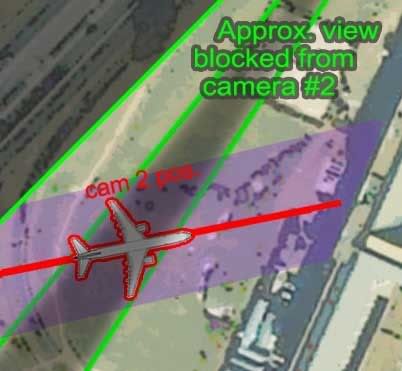
I had rebelled against the "black tailfin," insisting on seeing only a slight, irrelevant extension of an already high point on the skyline, but this really does look like a tailfin. When it comes to the chassis, I'd expect sunlit silver glare to dominate, and certainly not the all-black plane Cat Herder saw. But looking on the north side and as the plane was beginning its starboard bank, the visible side would be in shadow. But again, how could the whole plane, including its massive banking right wing stay hidden in that blind spot without peeking over or to the left? Is the high point the banking right wing and engine? No - the wing would catch sunlight at almost any angle but sideways, and the engine would glint at any angle. Only the tailfin can do this darkness trick, which makes the tailfin there seem possible and makes the white again seem like smoke.
In short, I'm confused again. Nonetheless...

In May 2006 the full video the stills were taken from, along with a second video from a different camera that has no such obstruction of view, was released by Judicial Watch. In this new view, besides a horrible glare and what looks like a splat of bird crap, we see the blur alone and unobstructed, if just the tip of it at far right. In this shot at least this is clearly NOT a smoke or vapor trail unless of an invisible craft, and strangely about the same color as the possible smoke recorded by cam 2. Although less of it is visible, we also see more clearly a shape to it. It looks like it's again underpinned by a shadow. Even adjusting for light distortion, this looks much bigger than a Global Hawk or other smaller craft often cited.

But the shapes do seem to fit nicely, giving us something like this, resembling a giant ghost Albatross. I can't tell you how exactly this must be a 757, nor can I see how anything else could be readily identifiable in this ill-defined cluster of optic distortions. But it's of a good size, the largest number of eyewitnesses described an AA liner, and something like a 757 seems to have damaged the building and killed nearly 200 people there within the next couple of seconds. You do the math. My best guess still, after looking at all this, is the "tailfin" is nothing more than some kind of digital "artifact" after all. But I'm still looking at it...










No comments:
Post a Comment